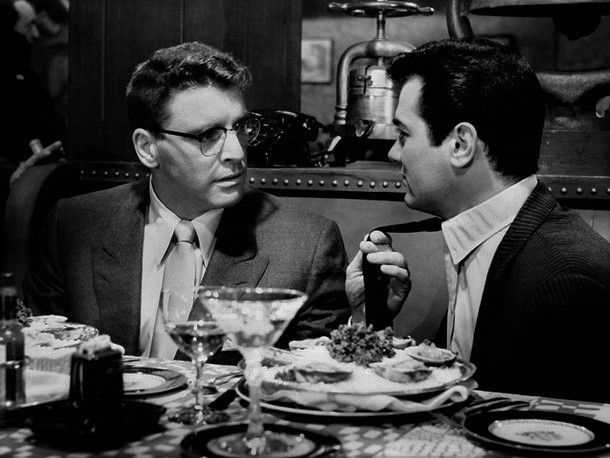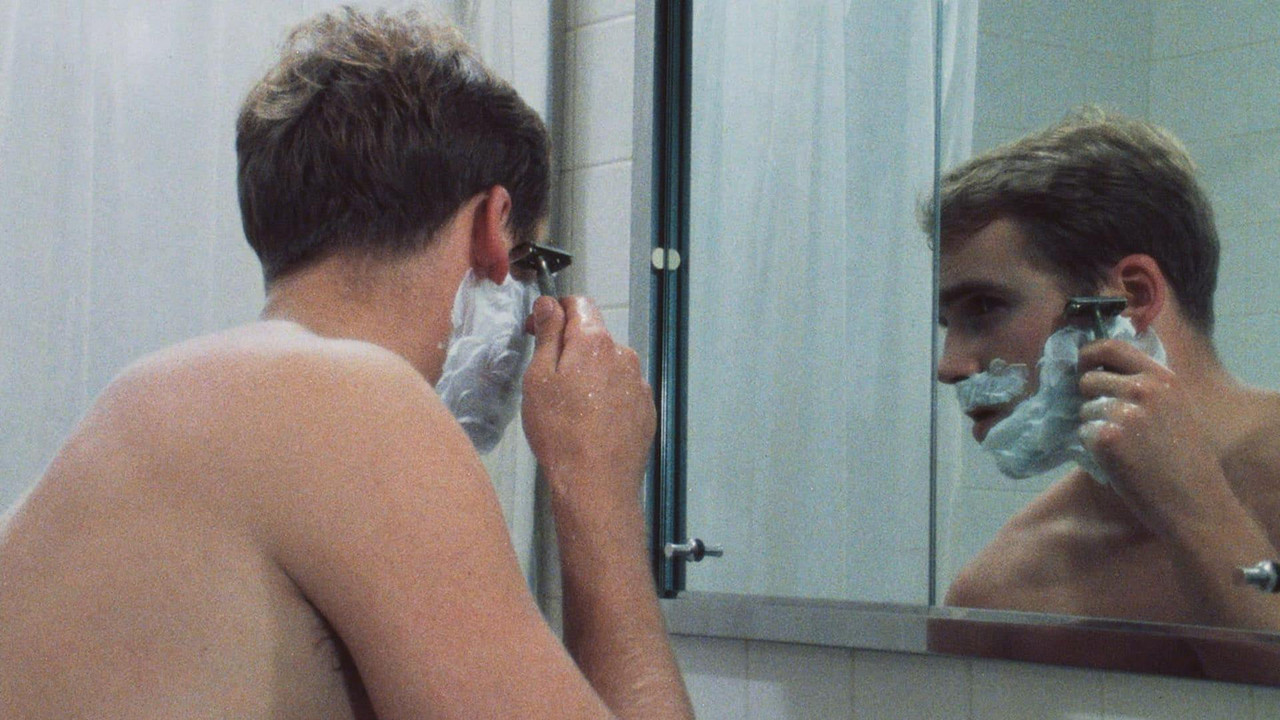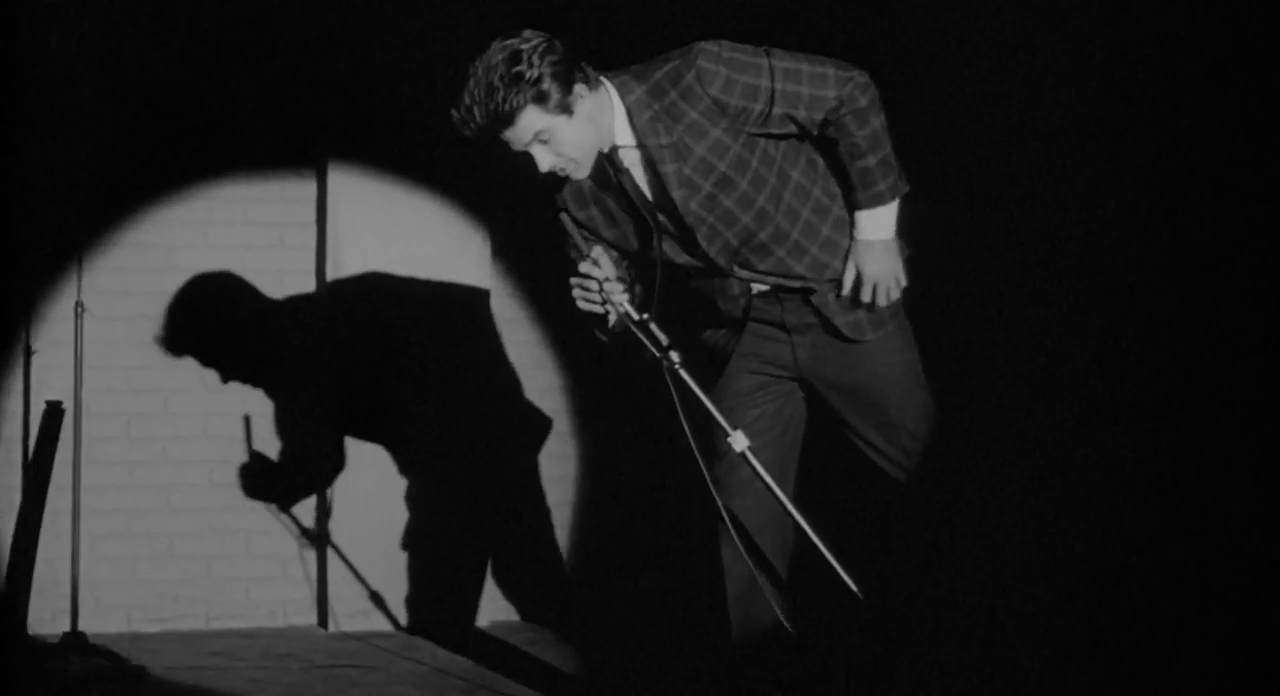“I'd hate to take a bite outta you. You're a cookie full of arsenic.”Sweet Smell of Success (Alexander Mackendrick, 1957)
April 20
20
oysters

J.J. Hunsecker (Burt Lancaster) pulling Sidney Falco's (Tony Curtis) tie over cocktails and oysters. DP: James Wong Howe.
– J.J. Hunsecker
jazz
“Have you seen Mr Tavernier tonight?”Ascenseur pour l'échafaud [Elevator to the Gallows] (Louis Malle, 1958)
Dec
13
croissants

Mr Tavernier (Maurice Ronet) taking a bite out of a croissant while dialling a number in a lively French café. A blonde behind him shows an interest. DP: Henri Decaë.
“I've been consulted by Franklin D.,
Gretta Garbo has had me to tea,
Still I'm broken hearted,
Cause I can't get it started,
With you”The Big Shave [The Big Shave… or, Viet '67] (Martin Scorsese, 1967)
Dec
2
Safety Razor Day

A young man (Peter Bernuth) shaving in front of a mirror. The bathroom is clean, white, with chrome fixtures. DP: Ares Demertzis.
Someone shaves on Safety Razor Day (USA)
Accompanied by the sweet tunes of Bunny Berigan and Ira Gershwin's I Can't Get Started, a young man shaves his face. The Big Shave is a short commissioned film which contains many of the hallmarks of Martin Scorsese's later, more accessible work.
–Ira Gershwin, I Can't Get Started (1936)
There's also the obvious influence of #KennethAnger to be found, in nostalgic show tunes, the fetishisation of chrome and clean lines, followed by lustful, by ways erotic, violence. #Scorsese theme here is not homoeroticism, not on the surface at least, but the carnage laid upon so many young men sent off to the smouldering battlefields of #Vietnam. There'd be another six years of that. And meanwhile, some young men came back. And some picked up a job, driving a cab.
“À bas le colonialisme ! À bas l'imperialisme !”Festival panafricain d'Alger [The Panafrican Festival in Algiers] (William Klein, 1969)
Jul
26
One Voice Day

Black hands holding each other. In translation the caption reads “Down with colonialism! Down with imperialism!”. DP: William Klein et al.
In typical Western fashion the credits for William Klein's Festival panafricain d'Alger focusses on the French and American participants. After Algeria regained its independence in 1962, it became Africa's – and the #AfricanDiaspora's – centre for postcolonial and liberation moments.
The 12-day Festival panafricain attracted 5000 people from all over the African continent, as well as liberation fighters from the United States.
“Do you think that not getting caught in a lie is the same as telling the truth?”The Slender Thread (Sydney Pollack, 1965)
May
10
National Washington Day

Lobby card. Psychology student Alan Newell (Sidney Poitier), hands in pockets, phone tucked between ear and shoulder, pacing up and down his office in the Crisis Clinic. DP: Loyal Griggs.
Expecting an uneventful night at the Seattle Crisis Clinic, volunteering psychology student Alan Newell is left to his own devices. Alan takes his books to study, it is quiet after all. Then a call, a woman. We learn she's called Inga (Anne Bancroft). She's drowsy. She has taken barbiturates and wants to talk while slipping away. While Alan fights to keep the woman on the line, attempts are made to trace the call.
– Mark Dyson
The Slender Thread is an excellent example of picturing the invisible. The two leads never meet, both bound to their setting. The call tracing scene, a very technical affair, bears echos of Soviet Montage. The warm #jazz soundtrack by Seattle's own Quincy Jones tones down the mechanics, making the human aspect even more harrowing, almost physical.
“I'm the king of the silent pictures. I'm hiding out till talkies blow over.”Mickey One (Arthur Penn, 1965)
Apr
8
Step Into The Spotlight Day

Mickey (Warren Beatty) bent over, holding a microphone with a bright spotlight aimed at him. DP: Ghislain Cloquet.
Warren Beatty plays Mickey, a #StandUpComedian who has it all, then gambles it all away. Well, that's the first 5 minutes of Arthur Penn's Mickey One. Beatty is out of his element, and the movie's still too indebted to the cheery 60s to carry that New American Cinema grit.
– Mickey One
Having said that, there are several great small surreal moments that are carried by uncredited character actors alone. And then there's a sole spotlight, stealing it all away.
“Ik schilder als een barbaar van deze barbaarse tijd.” De werkelijkheid van Karel Appel [The Reality of Karel Appel] (Jan Vrijman, 1962)
Feb
3
American Painters Day

Appel at work. He said about painting “Ik begin vanuit mijn materie, dat is verf.” (“I start from my matter, which is paint.”). DP: Eduard van der Enden.
CoBrA (1948—51) was a Copenhagen / Brussels / Amsterdam art collective whose manifest revolved around the liberation from the rigidity of art and life in drab, post-war Europe. Their spontaneous primal iconography and graffiti allowed them to not only regain the pleasure of painting, but also forge a new connection to colour and material. Especially the Dutch artists involved – Corneille, Appel, Lucebert, Constant – looked at the way children respond to the act of creation resulting in easy to comprehend semi-abstract paintings, sculptures and poems. The moronic “my child can paint that” that people still associate with modernist art can be traced back to (deliberately) misinterpreting these artists' objectives.
– Karel Appel
After CoBrA broke up, Appel started treating his canvas not as something that merely props up an image, but as part of the artwork itself. Working in layers of paint and other media, with any tool at hand, he'd build a sculptural object that incorporates the movement of both artist and material. In order to film De werkelijkheid van Karel Appel, he cut a hole in the canvas through which the camera captures the physicality of the action and the emotional involvement of the artist.
For this film, and Karel Appel, Componist by photographer Ed van der Elsken (1961), Appel (in collaboration with Frits Weiland) composed tape loops to create a wall of sound complementing the image.
“I pledge allegiance to the flag–the white flag. I pledge allegiance to the flag of America. When they say “black” or “negro,” it means you’re not an American. I pledge allegiance to your flag. Not that I have to, but just for the hell of it I pledge allegiance. I pledge allegiance to the flag of the United States of America. The white flag, with no stripes, no stars. It is a prestige badge worn by a profitable minority.”Mingus: Charlie Mingus [Mingus / Mingus In Greenwich Village] (Thomas Reichman, 1968)
Jan
20
National Charlie Day

Charles Mingus and Carolyn sharing an intimate father/daughter moment in their studio. DPs: Lee Osborne & Michael Wadleigh.
Thomas Reichman follows bandleader and musician Charles Mingus in those tense hours on November 22, 1966, right before he's forced to evict his #GreenwichVillage studio.
– Charles Mingus
Between the banter (“This is the same gun they shot Kennedy with”) and magical moments between the giant and his little daughter, we see and hear Mingus perform at Lennie's-On-The-Turnpike in Peabody, Massachusetts.